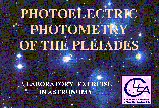

OF THE PLEIADES |
|||
 |
Required Windows SoftwareThis is a zip file that contains an .exe file that will install itself when you run it on your computer.
|
||
| Purpose: To familiarize students
with the technique of photoelectric filter photometry and counting statistics.
To acquaint students with the use of a computer controlled telescope. To
illustrate the use of equatorial coordinates for finding stars in a cluster.
To introduce the use of H-R diagrams for analyzing the age and distance
of clusters.
The software for this exercise puts students in control of a computer-controlled telescope with sidereal tracking (the "tracking" must be turned on or stars drift out of the field of view. Two fields of view are provided, a "finder" view of 2.5 degrees, and a magnified "instrument" field of view of 15 arc minutes. In the instrument mode, students see the outline of an aperture superimposed on the field. This marks the position of the entrance aperture of a photon- counting photometer. Controls are available to set one of three filters (U,B,V), to set the length of integrations and the number of integrations. Once these controls are set, students can take readings of the number of photons received from either a star in the aperture or from the sky (if no star is in the aperture). In the configuration most suitable for introductory students, the program automatically calculates stellar magnitudes from the count rate, as long as a sky reading has been taken through a given filter sometime before the star is observed. For upper- class students the magnitude calculation can be suppressed and students can use the raw star and sky counts to calculate magnitudes. Information on the signal-to-noise ratio is also displayed after each series of integrations. A student guide supplied with the software describes how to use B and V photometry of cluster members to plot an Hertzsprung-Russell diagram of the Pleiades and to determine its distance. We provide a database of stars in the Pleiades, but the data files for the stars are text files which can be modified by the user, so that data on any cluster can be substituted for the Pleiades, and exercises on the comparative ages of star clusters are possible. A utility called GENSTAR is available from CLEA which generates customized files of star fields for use in this program.
|
 Overview
of Software Overview
of Software |
 CLEA
Home Page CLEA
Home Page |